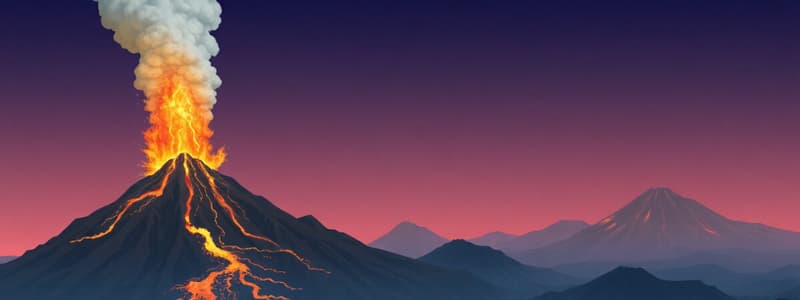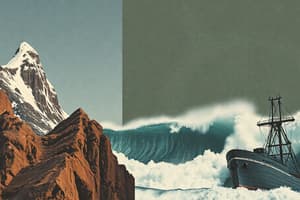Podcast
Questions and Answers
What are foreshocks and how can they be identified?
What are foreshocks and how can they be identified?
Foreshocks are smaller earthquakes that precede a larger one and can only be identified as such after the larger earthquake occurs.
What happens to a city located at the epicenter of an earthquake?
What happens to a city located at the epicenter of an earthquake?
A city at the epicenter experiences the strongest tremors and the most damage.
Define aftershocks.
Define aftershocks.
Aftershocks are smaller earthquakes that occur following the main shock of a larger earthquake in the same area.
What does the magnitude of an earthquake measure?
What does the magnitude of an earthquake measure?
Name one characteristic of earthquake movement.
Name one characteristic of earthquake movement.
What is the point inside the Earth where an earthquake originates called?
What is the point inside the Earth where an earthquake originates called?
What do we call the earthquakes that occur before a larger earthquake?
What do we call the earthquakes that occur before a larger earthquake?
What is the term for smaller earthquakes that follow a larger main earthquake?
What is the term for smaller earthquakes that follow a larger main earthquake?
What is the epicenter of an earthquake?
What is the epicenter of an earthquake?
How is the magnitude of an earthquake measured?
How is the magnitude of an earthquake measured?
What is one benefit of volcanic eruptions related to soil?
What is one benefit of volcanic eruptions related to soil?
How can volcanic eruptions contribute to land formation?
How can volcanic eruptions contribute to land formation?
What is a negative effect of pyroclastic flows from volcanic eruptions?
What is a negative effect of pyroclastic flows from volcanic eruptions?
How can volcanic ash negatively impact agriculture?
How can volcanic ash negatively impact agriculture?
What is one effect of volcanic eruptions on human population dynamics?
What is one effect of volcanic eruptions on human population dynamics?
What happens during the active stage of a volcano?
What happens during the active stage of a volcano?
How long does the dormant stage of a volcano typically last?
How long does the dormant stage of a volcano typically last?
What is a key characteristic of a dormant volcano?
What is a key characteristic of a dormant volcano?
What term is often used to describe a dormant volcano?
What term is often used to describe a dormant volcano?
What potential does a dormant volcano have?
What potential does a dormant volcano have?
What does it mean when a species is described as extinct?
What does it mean when a species is described as extinct?
What implication does the phrase 'said to be dead' have regarding the species?
What implication does the phrase 'said to be dead' have regarding the species?
How long does regeneration take according to the description?
How long does regeneration take according to the description?
What does the statement 'has not corrupted 1000 years' suggest about the species?
What does the statement 'has not corrupted 1000 years' suggest about the species?
Is the description referring to a traditional instrument? Explain.
Is the description referring to a traditional instrument? Explain.
What are the cracks in the Earth's crust called where plates move alongside or away from each other?
What are the cracks in the Earth's crust called where plates move alongside or away from each other?
What occurs when two tectonic plates collide at convergent boundaries?
What occurs when two tectonic plates collide at convergent boundaries?
In a collision between a more dense oceanic plate and a less dense continental plate, what happens to the oceanic plate?
In a collision between a more dense oceanic plate and a less dense continental plate, what happens to the oceanic plate?
What is the general movement of plates at a convergent boundary?
What is the general movement of plates at a convergent boundary?
What type of tectonic activity is linked to the existence of faults?
What type of tectonic activity is linked to the existence of faults?
What occurs at oceanic-continental convergence zones?
What occurs at oceanic-continental convergence zones?
What geological feature is commonly formed as a result of oceanic-continental convergence?
What geological feature is commonly formed as a result of oceanic-continental convergence?
How does oceanic-continental convergence lead to volcanic activity?
How does oceanic-continental convergence lead to volcanic activity?
Can you name two plate boundaries associated with oceanic-continental convergence?
Can you name two plate boundaries associated with oceanic-continental convergence?
What type of plate is denser: oceanic or continental?
What type of plate is denser: oceanic or continental?
What geological process leads to the formation of an island arc?
What geological process leads to the formation of an island arc?
What characterizes the convergence that forms mountain ranges?
What characterizes the convergence that forms mountain ranges?
Explain what occurs during the subduction process.
Explain what occurs during the subduction process.
How does the sinking of the denser oceanic plate affect land formation?
How does the sinking of the denser oceanic plate affect land formation?
Identify two geological features formed by the collision of oceanic plates.
Identify two geological features formed by the collision of oceanic plates.
Flashcards
Earthquake Movement
Earthquake Movement
Earthquakes can cause both vertical and horizontal shifts in the Earth's surface.
Epicenter
Epicenter
The point on Earth's surface directly above where an earthquake originates.
Foreshocks
Foreshocks
Smaller earthquakes that occur before a larger earthquake in the same location.
Aftershocks
Aftershocks
Signup and view all the flashcards
Earthquake Magnitude
Earthquake Magnitude
Signup and view all the flashcards
Earthquake Origin
Earthquake Origin
Signup and view all the flashcards
Hypocenter
Hypocenter
Signup and view all the flashcards
Volcanic Soil
Volcanic Soil
Signup and view all the flashcards
Land Formation
Land Formation
Signup and view all the flashcards
Volcanic Aquifers
Volcanic Aquifers
Signup and view all the flashcards
Volcanic Tourism
Volcanic Tourism
Signup and view all the flashcards
Pyroclastic Flows
Pyroclastic Flows
Signup and view all the flashcards
Volcanic Infrastructure Damage
Volcanic Infrastructure Damage
Signup and view all the flashcards
Volcanic Health Impacts
Volcanic Health Impacts
Signup and view all the flashcards
Volcanic Crop Damage
Volcanic Crop Damage
Signup and view all the flashcards
Volcanic Displacement
Volcanic Displacement
Signup and view all the flashcards
Active Volcano
Active Volcano
Signup and view all the flashcards
Dormant Volcano
Dormant Volcano
Signup and view all the flashcards
Plate Tectonics
Plate Tectonics
Signup and view all the flashcards
Faults
Faults
Signup and view all the flashcards
Convergent Boundaries
Convergent Boundaries
Signup and view all the flashcards
Subduction Zones
Subduction Zones
Signup and view all the flashcards
Oceanic-Continental Convergence
Oceanic-Continental Convergence
Signup and view all the flashcards
Oceanic-Oceanic Convergence
Oceanic-Oceanic Convergence
Signup and view all the flashcards
Third Type of Convergence
Third Type of Convergence
Signup and view all the flashcards
Island Arc
Island Arc
Signup and view all the flashcards
Archipelago
Archipelago
Signup and view all the flashcards
Study Notes
Earthquake Characteristics
- Earthquakes can move both vertically and horizontally.
- The epicenter of an earthquake experiences the strongest tremors and most damage.
- Foreshocks are smaller earthquakes that occur before a larger earthquake in the same location.
- Aftershocks are smaller earthquakes that occur after a larger earthquake in the same location.
- Magnitude measures the energy released during an earthquake.
Earthquakes
- Earthquakes are sudden movements below the Earth's surface along a transform fault.
- The hypocenter is the point inside the Earth where an earthquake originates.
- The epicenter is the point on the Earth's surface directly above the hypocenter.
Benefits of Volcanic Eruptions
- Soil fertility
- Land formation (e.g., new islands, peninsulas)
- Ecosystems aquifiers
- Geographical tourism
Negative Effects of Volcanic Eruptions
- Pyroclastic flows can be destructive.
- Damage to civil infrastructure.
- Negative health impacts.
- Ash can damage crops.
- Population displacement.
Stages of a Volcano
- Active Stage: Lava and ash are frequently released.
- Dormant Stage:
- 10-15 years of inactivity.
- Steam is released.
- Has the potential to erupt again.
- Often described as "sleeping".
Plate Tectonics
- The Earth's crust is made up of plates that move.
- Faults: Cracks in the Earth's crust where plates move alongside or away from each other.
- Convergent Boundaries: Plates move towards each other and collide.
- Collisions can form subduction zones.
- A denser oceanic plate (SIMA) can sink under a less dense continental plate (SIAL).
Oceanic-Continental Convergence
- Occurs at subduction zones like the Australian subduction zone and the Eurasian plate.
- The denser oceanic plate sinks beneath the continental plate, forming a deep ocean trench.
- Volcanoes often form above these zones.
Formation of Island Arc or Archipelago
- Occurs when two oceanic plates collide, with one sinking below the other.
- Creates a subduction zone and an island arc or archipelago behind the denser plate.
Third Type of Convergence
- This convergence leads to the formation of mountain ranges and high plateaus.
Studying That Suits You
Use AI to generate personalized quizzes and flashcards to suit your learning preferences.





